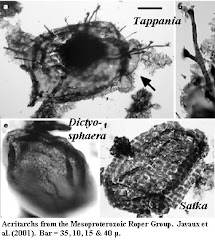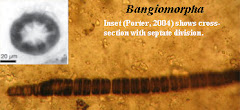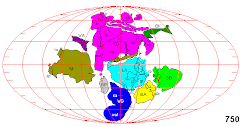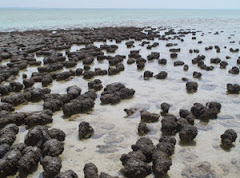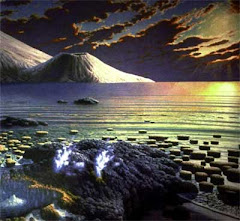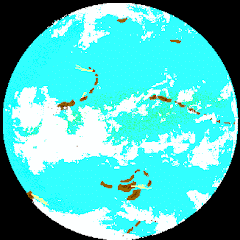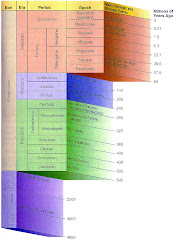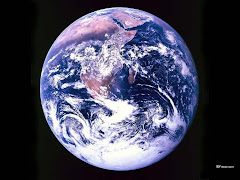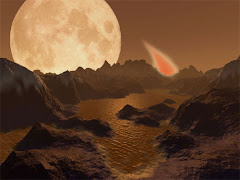The Proterozoic Eon is one of four eons of time making up the history of this planet. It is the third of four eons, the first two with little preserved life, the last two with it. The eons include the Hadean, the Archean, the Proterozoic, and the Phanerozoic. Proterozoic means “early life” and extends from 2500 million to approximately 542 million years ago. Traditionally, all eras prior to the Cambrian period (which began 542 million years ago) were informally referred to as the “Pre-Cambrian”, but more recently these time periods were divided up and named.
Originally, the Proterozoic Eon referred to the era prior to the emergence of numerous multicellular fossils. However, relatively recent discoveries of complex pre-Cambrian organisms called the Ediacaran biota have thrown this convention into disarray. These only appeared a few tens of millions of years before the Cambrian, however, so the rough outline of the Proterozoic is still correct. The Proterozoic Eon is split into three geologic eras of roughly equal duration: the Paleoproterozoic, Mesoproterozoic, and Neoproterozoic.
The Proterozoic makes up more than half of the history of life on earth. Although life did originate prior to the Proterozoic, much of it is very poorly preserved, and little about it is known. Even fossil details from the Proterozoic are sketchy. The early portion of the era was dominated, perhaps exclusively, by single-celled photosynthetic organisms which are the descendents of today’s cyanobacteria. These sometimes gathered into colonies resembling beads on a string. Some of the more complex specimens were closely integrated colonies of prokaryotic cells, reaching as much as 1 mm in size, considered to be among the earliest eukaryotes (complex, larger cells).
During the beginning of the Proterozoic, the atmosphere had 100 to 1000 times the carbon dioxide content of today’s, making it more similar to the atmosphere of Mars than the present-day Earth with which we are familiar. Relatively abruptly about 2000 million years ago, oxygen-producing photosynthesizing single-celled organisms evolved, releasing tremendous amounts of oxygen in an event known as the oxygen catastrophe. This rusted all exposed iron on the surface, leaving behind geological evidence called banded iron formations. It probably also caused mass extinction among organisms unable to deal with such high oxygen concentrations.
Towards the end of the Proterozoic, about 800 million years ago, the planet was hit with an Ice Age so hard that many paleontologists believe most of the Earth was covered in glaciers. This period is called the Cryogenian for its low temperatures. Remarkably, life survived, perhaps in slightly warmer lakes deep beneath the frigid surface, like today’s Lake Vostok in Antarctica.
By the end of the Proterozoic, the unicellular ancestors of today’s animals, plants, and fungi had appeared, as well as some primitive blob and stalk-like organisms. In general, data about Proterozoic organisms is very scarce in comparison to eras that came after it. Lacking hard shells, these organisms did not preserve very well. The most common remnants are mysterious microfossils called acritarchs which come in a variety of shapes and sizes. They are thought to be the fossils of unicellular photosynthetic protists.
October 6, 2008
Archean Eon
The Archean Eon is the second geologic eon in the Earth's history, beginning at the end of the Hadean Eon 3800 million years ago (mya) and extending to the start of the Proterozoic Eon 2500 mya. Unlike more recent eons when life was abundant, the Archean is defined by arbitrary date limits rather than the presence or absence of certain fossils. It would be safe to say that the Archean eon was a very long time ago, as is reflected in its name, which means old.
The origin of life happened sometime in the early Archean, approximately 3.5 billion years ago. This is corroborated by fossil evidence in the form of stromalites, the remnants of simple microorganisms which created thick layers of biotic muck as they died. The Archean begins shortly after a drawn-out series of events called the Late Heavy Bombardment, during which pieces of solar debris which had not yet formed into planets were getting drawn into the gravity well that is the Earth. Some biologists believe that this bombardment was ameliorated by the presence of the massive planet Jupiter, which would have sucked up some of the largest asteroids before they could impact our fragile planet.
In the Archean, the Earth's heat flow was about three times what it is today, and there was no free oxygen, the atmosphere mainly being composed of carbon dioxide. Oxygen was poisonous to most of the microorganisms existing at the time, in fact. Instead of rust, the surface had deposits of free iron. No stable continents existed, rather, they were constantly getting reshuffled as a result of geological activity and cometary impacts.
Some of the world's oldest rocks date back to the Archean, or even before, in the Hadean. According to geologists, only 5-40% of the current continental crust formed during the Archean. Volcanic activity would have been much greater than it is today, and many of the earliest proto-continents were likely formed by huge volcanic eruptions. Due to the large amount of carbon dioxide in the atmosphere, the oceans would have been more acidic than today, and hostile to all but the most extremophilic of present-day organisms.
The origin of life happened sometime in the early Archean, approximately 3.5 billion years ago. This is corroborated by fossil evidence in the form of stromalites, the remnants of simple microorganisms which created thick layers of biotic muck as they died. The Archean begins shortly after a drawn-out series of events called the Late Heavy Bombardment, during which pieces of solar debris which had not yet formed into planets were getting drawn into the gravity well that is the Earth. Some biologists believe that this bombardment was ameliorated by the presence of the massive planet Jupiter, which would have sucked up some of the largest asteroids before they could impact our fragile planet.
In the Archean, the Earth's heat flow was about three times what it is today, and there was no free oxygen, the atmosphere mainly being composed of carbon dioxide. Oxygen was poisonous to most of the microorganisms existing at the time, in fact. Instead of rust, the surface had deposits of free iron. No stable continents existed, rather, they were constantly getting reshuffled as a result of geological activity and cometary impacts.
Some of the world's oldest rocks date back to the Archean, or even before, in the Hadean. According to geologists, only 5-40% of the current continental crust formed during the Archean. Volcanic activity would have been much greater than it is today, and many of the earliest proto-continents were likely formed by huge volcanic eruptions. Due to the large amount of carbon dioxide in the atmosphere, the oceans would have been more acidic than today, and hostile to all but the most extremophilic of present-day organisms.
Hadean Eon
The Hadean eon refers to the earliest geological epoch of Earth’s history, from the formation of the planet about 4,500 million years ago, to the beginning of the Archean period, 3,800 million years ago. The name “Hadean eon” is derived from the word Hades the Greek word for Hell or “unseen”. It is commonly thought that the Hadean landscape was a lava-filled, meteorite-bombarded, lifeless place, but some scientists believe that this characterization is somewhat of an exaggeration, and that at least around the end of the Hadean eon, the Earth wasn’t as hellish as some might think. The fact is that we have relatively scarce evidence about the conditions on Earth at that time, relative to any other era.
The beginning of the Hadean eon was certainly a harsh place. It is when the Earth was nothing but a condensed portion of the accretion disk that made up the early Solar System. Over millions of years, this condensed portion started to chunk together by the mutual attraction of gravity, and a primitive proto-Earth was formed. Over a period of hundreds of millions of years, until about 4,100 million years ago, the Earth was quite hot. Convection and subduction churned the surface of the planet, creating a planetwide froth of magma. Heavier elements, like iron, lead, and iridium, sunk deep below the surface of the planet, forming its core. Lighter elements, such as gasses, rose to the top in spectacular outgassing events. The surface of the Earth was composed of silicates, which floated on top of the magma seas. Somewhere around the late-to-middle portion of the Hadean eon, the Earth began to cool and the outlines of the continents form. The atmosphere still lacked oxygen at this point.
An important event happened early in the Hadean eon, around 4,533 million years ago. The Earth was significantly smaller then, until it was impacted by a Mars-sized body known as Theia. This impact vaporized a huge portion of the crust, and sent many quadrillions of tons of material out into outer space, which hung around in the form of rings for a few million years, until these rings condensed into the body we now call the Moon.
Shortly after the Earth cooled, primitive life began, sometime around 4,000 million years ago. It is really remarkable how rapidly the first primitive cells appeared after the Earth cooled down. There is even some cursory evidence, traces of organic carbon in strata, that suggest photosynthetic organisms may have appeared around this time, around half a billion years earlier than previously thought. However, more evidence is needed to confirm this.
Around the end of the Hadean eon, the Earth - and other planets in the inner Solar System - were subjected to a 300 million-year event called the Late Heavy Bombardment. During this time, the number of asteroidand comet impacts increased greatly. Scientists are not sure why. It is worth noting that while the Late Heavy Bombardment signified a greatly increased number of impacts over what we see today, the time interval between large impacts could still be measured in centuries or millennia. Around this time, life had to function in an all-CO2 atmosphere, oxidizing inorganic materials for energy. Around the conclusion of the Hadean eon, primitive prokaryotic cells developed glycosis, a process for oxidizing organic molecules which set the foundation for modern life.
The beginning of the Hadean eon was certainly a harsh place. It is when the Earth was nothing but a condensed portion of the accretion disk that made up the early Solar System. Over millions of years, this condensed portion started to chunk together by the mutual attraction of gravity, and a primitive proto-Earth was formed. Over a period of hundreds of millions of years, until about 4,100 million years ago, the Earth was quite hot. Convection and subduction churned the surface of the planet, creating a planetwide froth of magma. Heavier elements, like iron, lead, and iridium, sunk deep below the surface of the planet, forming its core. Lighter elements, such as gasses, rose to the top in spectacular outgassing events. The surface of the Earth was composed of silicates, which floated on top of the magma seas. Somewhere around the late-to-middle portion of the Hadean eon, the Earth began to cool and the outlines of the continents form. The atmosphere still lacked oxygen at this point.
An important event happened early in the Hadean eon, around 4,533 million years ago. The Earth was significantly smaller then, until it was impacted by a Mars-sized body known as Theia. This impact vaporized a huge portion of the crust, and sent many quadrillions of tons of material out into outer space, which hung around in the form of rings for a few million years, until these rings condensed into the body we now call the Moon.
Shortly after the Earth cooled, primitive life began, sometime around 4,000 million years ago. It is really remarkable how rapidly the first primitive cells appeared after the Earth cooled down. There is even some cursory evidence, traces of organic carbon in strata, that suggest photosynthetic organisms may have appeared around this time, around half a billion years earlier than previously thought. However, more evidence is needed to confirm this.
Around the end of the Hadean eon, the Earth - and other planets in the inner Solar System - were subjected to a 300 million-year event called the Late Heavy Bombardment. During this time, the number of asteroidand comet impacts increased greatly. Scientists are not sure why. It is worth noting that while the Late Heavy Bombardment signified a greatly increased number of impacts over what we see today, the time interval between large impacts could still be measured in centuries or millennia. Around this time, life had to function in an all-CO2 atmosphere, oxidizing inorganic materials for energy. Around the conclusion of the Hadean eon, primitive prokaryotic cells developed glycosis, a process for oxidizing organic molecules which set the foundation for modern life.
Subscribe to:
Posts (Atom)
